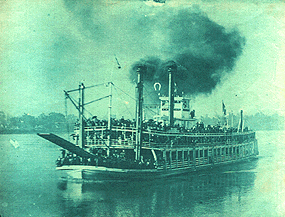



 |
Jazz centers of the 1920s: |
| New
Orleans:
In the late nineteenth century and early twentieth century,
African American musicians
began gathering in New Orleans. They would congregate to improvise
and share their music in Storyville.
Early jazz musicians often called New Orleans their home, even if they
spent little time there. By 1920, New Orleanian jazz musicians had
already spent years spreading the "New Orleans sound" throughout
the nation ( the word "jazz" did not enter our vocabulary until 1917).
Jelly
Roll Morton began touring as early as 1906. Despite the
attempts of these musicians to increase the popularity of New Orleans jazz
music nationwide, jazz music remained almost exclusively "The sound of
New Orleans." In the early 1920s, the first real stars of jazz surfaced.
Artists such as King Oliver, Louis Armstrong, and Kid Ory established
well known reputations for their original jazz music.
|
| Chicago:
|
| New
York:
The early New York Jazz music was influenced by ragtime music, which had
been popular there in the early 1900s. Scott Joplin had played in New
York, and other great musicians followed in his footsteps. After The
Original Dixieland Jazz Band played on Broadway, jazz musicians imitated
the New Orleans sound. While not attaining the undisciplined and wildly
erratic beat of New Orleans jazz, the popularity of jazz in New York
increased drastically. The 1920s proved to be a Golden Age of jazz in New
York. Jazz was diverse and appealed to people from every echelon of
society. Louis Armstrong broke away from King Oliver's band and moved to
New York, creating a whole new genre of jazz improvisation.
|
|
Kansas City: By 1920, Kansas city was booming. Jazz could be heard on nearly every street corner. Jazz musicians poured into Kansas City after the mass exodus from New Orleans. The city was completely segregated. African American jazz musicians were in high demand in the white dance halls and clubs, and the African American jazz clubs. Hotel restaurants in Kansas City were also known for employing elaborate jazz ensembles. There were over fifty jazz clubs in one six block district. Kansas City was often a resting place for musicians on their way to California, Chicago, or New York. One of the most famous early jazz musicians, Benny Moten, was a native of Kansas City. He was largely responsible for the spread of jazz in Kansas City in the early 1920s. Walter page and Bill Basie (later known as "Count Basie") joined Moten's band in 1928, and formed the most outstanding jazz band in the city. One of the most significant contributions of the Kansas City jazz musicians was the way they propelled jazz toward the Big Bands of the 1930s. The bands grew steadily in size throughout the 1920s. For example, Benny Moten's band consisted of six musicians in 1923, eight musicians in 1924, and by 1926, the band was made up of ten musicians. The saxophone was the most important individual instrument in Kansas City during the 1920s. Jazz musicians all over the country referred to Kansas City as "The Home of the Sax." The "riff" was the most identifiable characteristic of Kansas City jazz. A riff is a musical pattern or phrase that is repeated by one voice while a soloist improvises a melody. The riff increased the popularity and importance of the saxophone to jazz music. |

